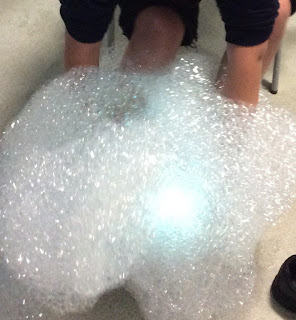 |
| Friends forever! |
I recently read an article on the BBC News website about attacks on Teaching Assistants in special schools. The implication was that they felt that suffering violence was seen by leadership to be part of their job and to be ‘expected’. Having worked in Complex Needs Schools for most of my working life, I know exactly how they feel. My team and I bear the scars, both physical and emotional, of working with children with extreme autism and associated learning needs. The close involvement with the pupils means that you do accept behaviours from them that you would not countenance in a mainstream school. However, that does not mean that these behaviours were accepted without question, and that is where I feel the article fell short.
While I appreciate that the main thrust of it was from the point of view of the adults, nothing was said about possible reasons for challenging behaviour. In my experience, the first thing that teams in these situations ask is ‘why?’ What is it that the child is trying to tell us? Because there is little doubt, in my mind at least, that for non-verbal children with autism, behaviour is their most basic form of communication.
 |
| A better way... |
They may well be laying on the floor screaming, but what are they trying to tell you? There could be any number of reasons, from physical discomfort to not understanding what is happening next. The onus on the professionals involved is to carefully observe and come up with a hypothesis as to what is going on for individual children. In fact, one of the things I have missed the most since I retired is the ‘problem solving’ element of my job: How can I support children to learn? What is it that we need to change to support them? How can we teach them a better way of responding? Because while we recognised they were trying to tell us something, clearly we weren’t going to let our pupils think that kicking or spitting was an appropriate way to tell us!
 |
| Understanding emotions |
The only way, as a school, we had successful outcomes for some of our more challenging students was to alter the way we did things and provide them with a bespoke environment to meet their needs, and adapt the curriculum accordingly.
 |
| Working independently - Attention Autism |
The ‘Attention Autism’ programme transformed the way I taught. The basic premise is that if you want children to learn, you have to make it worth their while learning! It’s not easy - you need to be confident in what you are doing and show that the pupils are making progress.
It didn’t always work - some students need the level of support that only a 24 hour curriculum can provide - but when it did, it was amazing. By asking ourselves what those complex, stressed and anxious children were telling us with their challenging and, sometimes bizarre behaviour patterns we were able to slowly help them find better ways.
 |
| Addressing sensory needs |
It could have been through offering them visual support, teaching them to use symbols or pictures to communicate or addressing their sensory needs but the key was always consistency - it could be tedious and relentless, but it enabled us to build trusting relationships which lasted way beyond their time in our classes.
 |
| So engaged |
I still see one of my former pupils - he comes to cook his dinner in my house sometimes - and he still trusts that his friend and respite carer and me will behave and treat him in the same way as we always have. He even trusts us enough to have allowed us to persuade him to try ice skating at Christmas!
 |
| He really needed a taller penguin! |
When we listen to children and young people with autism, and successfully interpret what their behaviours are telling us it can be truly joyful.
 |
| A joyful relationship |
That is why you will find teachers and TAs in Complex Needs schools around the country putting up with far more than anyone should have to in their place of work.







